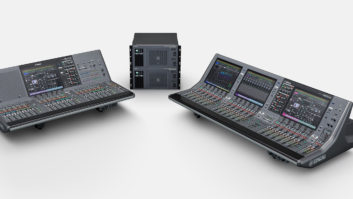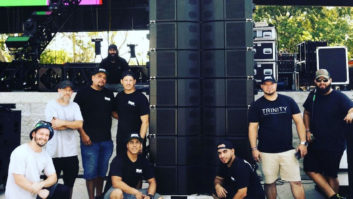DALLAS, TX—Multi-platinum-selling, Grammy Award-winning band Switchfoot recently wrapped up its 10-week Looking for America Tour with Grammy-nominated alt-rockers Relient K co-headlining all 51 shows. The two bands will team up again in mid-January 2017 for the Still Looking for America 2our, starting in California, Switchfoot’s home state.
Ryan Nichols, a 27-year veteran of the industry who has been with the band for the past 14 years as FOH engineer and production manager, took the opportunity on select dates to help roll out Bose Professional’s new ShowMatchDeltaQ array loudspeaker system, which was previewed at InfoComm 2016. ShowMatch’s USA road premiere included venues in Chicago, along the East Coast and in Dallas.
This was not Nichols’ first experience with a Bose Professional line array system. “I’ve used RoomMatch; it’s a great PA,” he says, during soundcheck at the Dallas House of Blues.
But RoomMatch and Show- Match are very different PAs in terms of their applications: “I’ve used RoomMatch in installs—and on the beach,” he admits, laughing, “where it was awesome.”
To create ShowMatch, Bose has essentially re-engineered RoomMatch into a lighter, louder package intended to withstand the rigors of the road. “They’ve done a really great job with it. I like the way the box sounds, the tuning is really nice and it definitely has the SPL. It’s easy to rig, easy to hang and it covers the room really well. I love mixing on it.”
Nichols was joined on the tour by monitor engineer Mark DiCicco. In addition to the ShowMatch rig, they also carried a mixing console each—an Avid Venue SC48 at FOH and a Behringer X32 at monitors—plus a microphone package. “We have Shure SM58s on vocals and SM57s on guitars,” Nichols reports. “My drum kit? Shure [Beta] beta 91 on the kick, a Heil PR20 on the snare top and a 57 on the snare bottom, [Shure] KSM137 on the hi-hat, Sennheiser e604s on the toms and Shure KSM32s on the overheads.”
Nichols has no outboard processing and uses minimal plug-ins: “Smack! on the vocals, Waves C6 on vocals and acoustic guitar; that’s pretty much it.”
Also on the ShowMatch dates was Sean Quackenbush, an experienced FOH engineer and production manager who has worked in recent years with Brandi Carlile, Matisyahu, KT Tunstall and the Black Crowes’ Rich Robinson, and was one of the main PA techs on Florence and the Machine’s fall 2015 U.S. tour. “I have experience putting rigs together and being a PA tech on a tour—the guy who gets it in, gets it up and gets it out of the way,” says Quackenbush. On the shows with the Bose rig, he says, “The truck showed up at 8 a.m., it was up and in the air before 10 a.m., and toned and tested before 11 a.m.”
Quackenbush put in some legwork prepping the rig before its Chicago debut. “I laid out the fly looms and did the labeling, making it foolproof. We tested every box individually but never fired up the whole rig. The first time we heard it was at the venue the day of the show.”
For the Dallas gig, the team flew two hangs of 14 ShowMatch modules with four boxes for lip fill and three ground-stacked RoomMatch RMS218 subwoofers per side. Four racks of six PowerMatch PM8500N amplifiers drove the main system, with two additional PM8500Ns available for front and auxiliary fill.
Bose Professional also took the opportunity to demonstrate its technology to representatives from some of the pro audio publications at the Dallas show. Morten Jørgensen, senior manager, Bose Professional, Americas, was available to explain that the DeltaQ concept—common to both ShowMatch and RoomMatch—enables operators to tailor the directivity in both the horizontal and vertical planes and surgically aim the sound at the audience.
“We believe it starts with vocal clarity. Any energy we shoot into the ceiling or the side walls is going to come back as reverberant energy and that’s going to decrease the clarity,” he says.
“If you’ve got to get sound all the way to the back, you need something with a high Q. To get to the middle, you need something a little wider to get out to the sides, and wide vertically as well. Up close to the array, you’ve got to cover the seats all the way at the sides, so you need something really, really wide horizontally, and wide vertically as well. Typically, the Q will vary as you go down the array—it’s a high Q at the top, and it gets lower and lower as you get down to the bottom—hence the name DeltaQ,” says Jørgensen.
All vocals on the Switchfoot tour were captured via Shure SM58 capsules on a UHF-R wireless mic.

Vertical directivity from the four compression drivers is dependent on the specific model of array module, which provides either 5, 10 or 20 degrees of coverage. Vertical pattern control is dictated by the curvature of the manifold holding the drivers. Horizontal pattern control is dictated by each box’s field-changeable waveguide. There are four options—55, 70, 100 and 120 degrees—and each module ships with one waveguide fitted plus an alternate, with other waveguides available as options. “Undo two screws on the top, two at the bottom, slide in the new waveguide and put the screws back in,” says Jørgensen, noting that the two waveguides do not have to be the same angle, allowing the creation of asymmetrical modules.
“The key thing about the compression driver is that it goes much lower in frequency than any other driver in the marketplace,” continues Jørgensen. “It starts at about 300 Hz; that allows us to crossover from the low to the mid frequencies at about 800 Hz. We don’t have to crossover in the middle of the vocal range. That gives us the clarity.”
Each two-way array module also features a pair of proprietary 8-inch neodymium woofers derived from RoomMatch counterparts. The ShowMatch woofer incorporates design changes that enables it to produce greater SPLs while minimizing thermal and power compression. A typical ShowMatch array can deliver up to about 145 dB peak. The Show- Match line also includes a single-18 sub that is physically and acoustically matched with the full-range modules.
Unique to the system is its ability to be arrayed in multiple configurations, including a standard constant curvature configuration, a J array for long-throw, high-SPL applications or a DeltaQ array. “No other product on the market can do all three of these array types from a single set. It gives you true flexibility,” says Jørgensen. Each array frame supports up to 24 modules or 18 subs.
The beauty of the ShowMatch DeltaQ module in an array, he adds, is that the SPL of the bottom boxes doesn’t have to be shaded, as it would be in a conventional rig. “A lower Q box has a lower output than a higher Q box—about a 6 or 7 dB difference—so you don’t have to turn the energy down.”
Tuning the set-up was relatively fast, reports Quackenbush. “We made very few tonality cuts to the boxes. At one venue, we scooped a little bit of the mid-low, just because there was a bit of build-up in the room.”
The tour was carrying a third-party processor. “But we never put it into play once. It was pretty much Ryan’s analog drive lines to our Bose ControlSpace processor and then over Dante to the amp racks,” says Quackenbush.
“The best part was watching Ryan barely do anything. There was never anything more than 2 or 3 dB cut on his EQ, and that was more for his taste than anything.”
Bose Professional
pro.bose.com
This article originally ran in the January 2017 issue of Pro Sound News as “Live Sound Showcase: Switchfoot Makes A Switch.”






